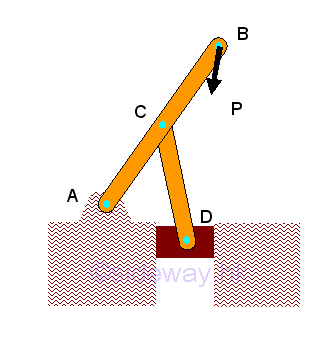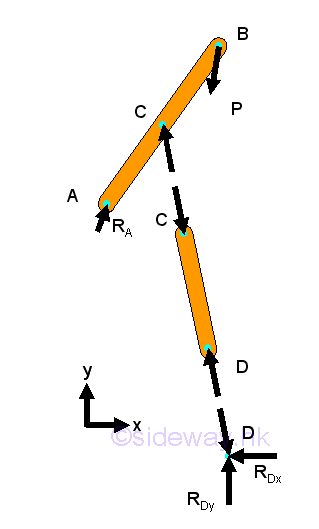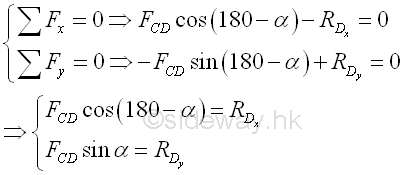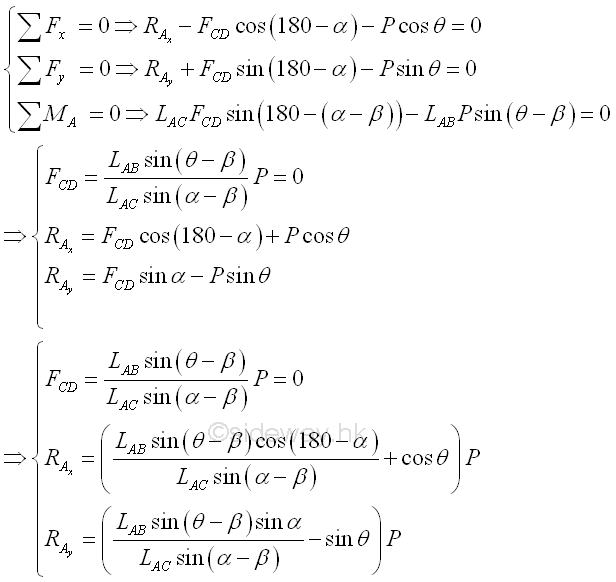Content
Machine
Stability:
Determinacy:
Forces Analysis:
Machine

Machine is the most common type of mechanical structure designed to transmit and modify forces. In general, machine likes frame structure always contain at least one multiple force member with forces, which are not all along the direction of member axis, acts on three or more positions the machine member. The main difference between machine and frame is the feature of the component parts. A machine always contain moving component parts. Therefore machine can be considered as a structure in the form of a simple tool or complicated mechanism designed for a specific mechanical function to transform input forces into output forces as per the mechancial function required.
Stability:
Since moving component parts are always included in machine design, a machine structure must be nonrigid. However, the supports and connections, and external applied force and loading of the machine always provide additional constraints to stabilize the shape of the machine. Therefore machine structure is usually unstable when the external forces applied to the machine structure are not equal to the specific design conditions.

Determinacy:
Since machine is considered as a nonrigid body, the three equilibrium equations of a rigid body usually cannot be used to determine a nonrigid machine. However, a nonrigid machine can usually be divided into rigid component parts. And unknown forces can therefore be determined using the three equilibrium equations of a rigid body by considering each rigid component part as a free body as in collapsible frame structure.
As in collapsible frame, a non-rigid, collapsible structure with suitable constraints is rigid and statically determinate. In general, the necessary condition for a structure to be rigid and statically determinate is the number of unknown forces equal to the number of the independent equations. And the structure should also be properly constrained. The equilibrium equations and unknowns of the machine can be obtained from drawing free-body diagram for each rigid component parts or for each machine member.
If there are more unknown forces than the independent equilibrium equations, the structure is statically indeterminate. If there are more independent equilibrium equations than unknown forces, the structure is unstable, or non-rigid. Only if the number of unknown forces is equal to the number of independent equilibrium equations, the unknown forces can be determined. If all unknowns can be determined and all independent equilibrium equations can be satisfied under general loading conditions, the structure is said to be statically determinate and rigid. However, if there is improper arrangement of frame members and supports, all unknowns cannot be determined and all equilibrium equations cannot be satisfied, and the structure is said to be statically indeterminate and non-rigid.
Forces Analysis:
Since the machine is collapsible after detached from the supports and connections, the machine cannot be considered as a rigid body. And in general, the three equilibrium equations of a rigid body also cannot determined the four unknown reactions of the collapsible machine.
Forces in machine members can therefore usually be determined by considering the machine structure as distinct component parts. Forces in a two-force member can only be either tensile or compressive forces. Forces acting upon the multi-force member are to be determined. Forces acting on a connecting joint should be in equilibrium.

At connecting joint D,

For the multiple force machine member AD,

©sideway
ID: 120300017 Last Updated: 3/27/2012 Revision: 0 Ref:
References
- I.C. Jong; B.G. rogers, 1991, Engineering Mechanics: Statics and Dynamics
- F.P. Beer; E.R. Johnston,Jr.; E.R. Eisenberg, 2004, Vector Mechanics for Engineers: Statics
Latest Updated Links
- Pentium(last updated On 7/3/2025)
- Intel CPU(last updated On 7/2/2025)
- Intel CPU History(last updated On 7/1/2025)
- FreeGLUT Windows Function(last updated On 1/27/2025)
- FreeGLUT Initialization Function(last updated On 1/26/2025)
- FreeGLUT(last updated On 1/25/2025)
- GLUT(last updated On 1/24/2025)
- OpenGL(last updated On 1/23/2025)
- XPower UC140 4-Port 140W PD3.1 GaN Travel Charger(last updated On 1/22/2025)
- XPower DX6 6 In 1 (2x3) 60W PD3.0 Sync & Charge Cable(last updated On 1/21/2025)
- XPower MF240 1.2M Magnetic Absorption 4 in 1 (2x2) Zinc Alloy 240W PD Sync & Charge Cable(last updated On 1/20/2025)

 Nu Html Checker
Nu Html Checker  53
53  na
na  na
na
Home 5
Business
Management
HBR 3
Information
Recreation
Hobbies 8
Culture
Chinese 1097
English 339
Travel 18
Reference 79
Computer
Hardware 257
Software
Application 213
Digitization 37
Latex 52
Manim 205
KB 1
Numeric 19
Programming
Web 289
Unicode 504
HTML 66
CSS 65
SVG 46
ASP.NET 270
OS 431
DeskTop 7
Python 72
Knowledge
Mathematics
Formulas 8
Set 1
Logic 1
Algebra 84
Number Theory 206
Trigonometry 31
Geometry 34
Calculus 67
Engineering
Tables 8
Mechanical
Rigid Bodies
Statics 92
Dynamics 37
Fluid 5
Control
Acoustics 19
Natural Sciences
Matter 1
Electric 27
Biology 1
